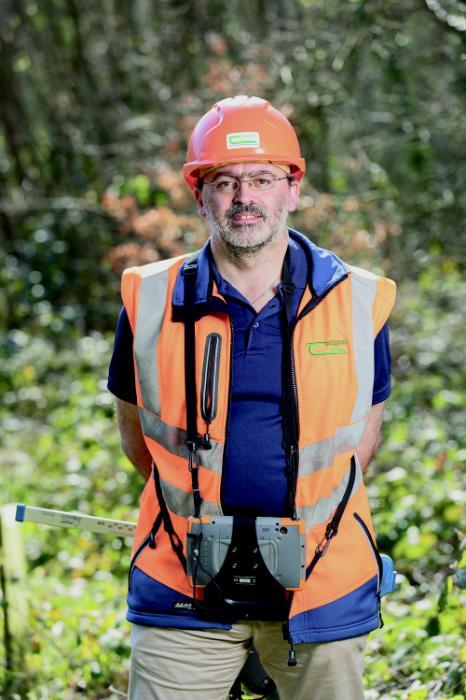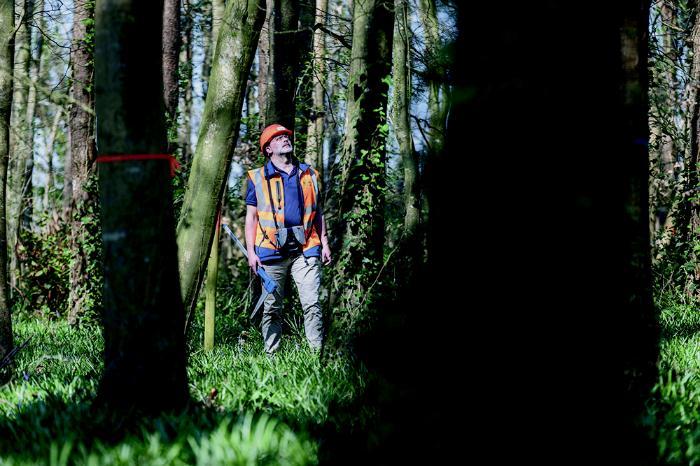12 June 2025
Interview: Seeing the forest for trees
Forestry Senior Research Officer Ian Short talks us through recent advances in closer-to-nature forestry, and why agroforestry means more than just land grants for growers.

Ian appreciates seeing agroforestry and Continuous Cover Forestry enjoy a “renaissance” as increasingly valid approaches in recent years. Photography: Finbarr O’Rourke
Ian Short grew up in Norfolk and always enjoyed being outdoors. When he was finishing school, he would go hiking, thinking about what he wanted to do, and what jobs get you outdoors. While on an interview at Bangor University in Wales for a forestry degree, one of the lecturers tipped him off about the agroforestry degree. It sounded like the ideal fit and ultimately brought him to where he is today.
Towards the end of his bachelor’s, Ian got a research assistant job at the Waterford Institute of Technology, where he also completed his master’s by research. This was followed by a Teagasc Walsh Scholarship to do his PhD in Agroforestry with Queen’s University, Belfast. At Teagasc, he initially interviewed for a important role in broadleaf silviculture but maintained his strong interest in agroforestry. The latter has turned out to be a topic of increased wider interest in the last five years.
What are the topics you work on? Why are they relevant?
Broadleaf silviculture is how you manage the growth of broadleaf trees – oak, beech, birch, etc., those that typically lose leaves in autumn. Silviculture is essentially the science and art of growing trees. I say “art” as there’s a bit of instinct or gut feeling to it. Given the long timelines involved in mapping tree growth, results can take decades to become apparent.
If you look at forestry from 150 years ago… the knowledge is there, but we need to align it to our more contemporary scientific approach.
A simple definition of agroforestry is “growing trees on farms”. More specifically, on farms with an interaction between agricultural enterprise and trees. So, your primary objective may not necessarily be timber production, but rather things like reducing lamb death, reducing water runoff, diversifying income. Agroforestry focuses on the grower’s perspective: what can planting trees do for the rest of your farm?
I work on a few projects. They share similarities in how long-term their timescale is, which sometimes differs from more immediate work elsewhere in Teagasc. For instance, I have sites where I’ve been working on the same thing for 15 years. This is rare, and a bit of a challenge because of the usual five-year scope of research funding. Agroforestry has only picked up in the past few years, but the projects there are long-term. It’s a topic that ultimately can intersect with every part of Teagasc; agroforestry systems can fit into almost any enterprise.
In this short video, he discusses his research interests including agroforestry, broadleaf silviculture and alternative silviculture systems.
What projects/research are you working on within these topics?
One project is work in Continuous Cover Forestry (CCF). The predominant management for forests is clear-cut or clearfell systems: trees grow, they reach a particular height, you fell them all and restart. Clearfelling has a public perception issue and possible environmental concerns.
By contrast, CCF is a management technique in which there are always some standing trees on-site. It’s a ‘closer to nature’ type of forestry; it tries to copy and use naturally occurring processes in forests, you end up with multispecies and multiculture forests, and the public tend to prefer the look and feel of CCF.
The normal management of forests involves planting, establishing growth, and then thinning – taking out inferior trees to give more space to the remaining trees to grow. We have two Sitka spruce stands – stands are almost like a paddock in forestry, an area of forest that’s quite homogenous, uniform in species composition and managed as a single unit.
We use these stands to investigate different approaches to thinning. The standard practice is low thinning, we’re comparing it against crown thinning and graduated density thinning.
Low thinning means removing lower-diameter trees; crown thinning means selectively removing trees that are competing in the canopy with selected superior trees; while graduated density thinning involves removing trees in a way that creates a more open and varied forest structure.
The long-term aim is to see how these approaches will facilitate the stands’ graduation to CCF and how they can introduce more variability into stands. Low thinning aims for uniformity, whereas crown and graduated is clumpier and variable, which is what we ideally look for in CCF.
The sites have now had four thinning cycles. We’ll continue monitoring the techniques and their effects – for example, the natural regeneration of seedlings, the economics of these management techniques, the volumes of timber coming out. It’s a very long-term process. Perhaps I’ll see the endgame by my retirement! So far, we’re seeing that graduated and crown have some improved regeneration and similar volumes harvested but with early sawlog harvesting.

Tree growth is a slow process, requiring a patient approach to achieve results. Photography: Finbarr O’Rourke
What are the benefits of this research?
There are so many benefits that can be accrued from agroforestry. There’s a policy – and grant – in Ireland to get more trees in the ground, and farmers are the landowners best placed to do this. The narrative currently is around encouraging farmers to plant trees to sequester carbon, support pollinators and biodiversity and improve water quality.
These societal benefits are great, but I think a way to drive this is by also highlighting the benefits to the planter. Trees provide shade and reduce heat stress for livestock, they can reduce lamb mortality by sheltering paddocks, they improve biodiversity in farm systems for grazing ruminants – and animals will know which plants to go to if they’re missing micronutrients in their diet, for example. And because trees intercept rainfall, improve soil infiltration and reduce erosion, this also improves water runoff levels to the farmyard.
What impacts does this work have?
Agroforestry can potentially be linked to all enterprises within Teagasc; it has potential positive impacts on carbon, soil, water, livestock, tillage, biodiversity, disease, pollination. As it’s still a relatively little-examined field, however, it will take a while to clarify all the benefits and for whom.
Agroforestry focuses on the grower’s perspective: what can planting trees do for the rest of your farm?
In terms of knowledge transfer, I provide technical support to the Irish Agroforestry Forum, established in 2020 to be a gateway to agroforestry knowledge and to facilitate projects demonstrating agroforestry’s value and applications. The forum combines research and support, and there are over 200 paid-up members now including farmers, landowners, foresters and other key stakeholders. I think having this knowledge transfer alongside research is beneficial in keeping your research grounded, relevant, and applicable to those real-world applications for stakeholders and industry.
In this radio programme, recorded at Teagasc Oak Park Research Centre in Carlow; Frances McHugh, Forestry Advisor and Dr Ian Short, Dr Dheeraj Rathore and Oliver Sheridan, research scientists, talk about the work that they do in relation to tree research and how it is translated into practical measures in the forest.
What are the challenges?
For CCF, the benefits are a harder sell. While observations so far suggest that there may be environmental benefits to it and it may have better public perception, the industry may assume that it’s less productive and more complex to manage compared to clearfelling. For researchers, then, it’s about providing the right data and evidence to promote the benefits of CCF to industry.
For both CCF and agroforestry, funding research is a challenge. The longest funding windows tend to be five years, and funding bodies want results and outputs, which can be a challenge to produce in a field that operates on much longer timescales.
What does the future hold?
Looking at how CCF in Ireland will affect carbon sequestration compared to other management types. There are few mature CCF sites currently as the concept is relatively new. Interest in the approach is growing, however; DAFM has introduced support schemes for both forest establishment and management that follow CCF principles.
In a way, agroforestry and alternative silviculture are “rediscovered” topics, along with ideas like multi-species swards or organic farming, for example. If you look at forestry and agriculture books from 100, 150 years ago, these ideas are all in there. It’s just that farmers and landowners have been incentivised in a different direction for the past century. The knowledge is there, but we need to find the confidence to apply it and to align it with our more robust, contemporary scientific approach.
Up close and personal
What’s your favourite animal?
Wolves; they’re team players, they work together well and can have a positive impact on their ecosystem. For birds, I like the Longtail Tit for similar reasons; they roost together to protect their flock.
If you hadn’t ended up in research, what other job would you have wanted to try?
As a kid I fancied being a long-distance lorry driver, but most likely I’d be a nature reserve warden otherwise.
What are you most proud of professionally?
Helping agroforestry develop as a field of research, mentoring students and working alongside such a good team in our department – especially the farm staff and technicians who make our research possible.
Further reading
You can read more about the impact of Ian’s work in Teagasc’s “Research Impact Highlights in 2023” at this link.
You can also read this paper by Rachel Irwin, Ian Short and Áine Ní Dhubháin titled ” Understanding the barriers and enablers to agroforestry adoption in Ireland through an innovation systems approach” at this link.
